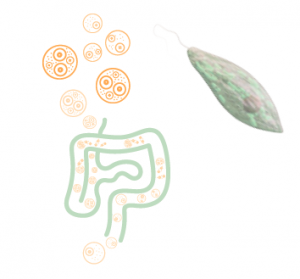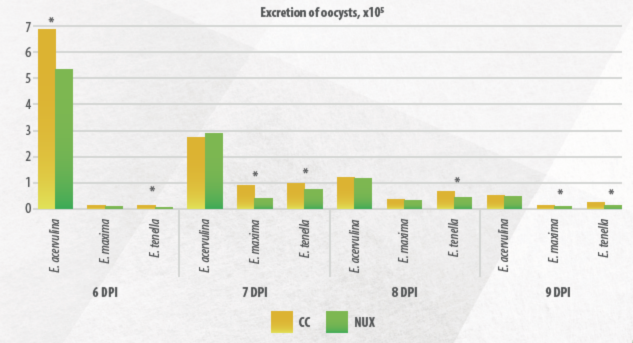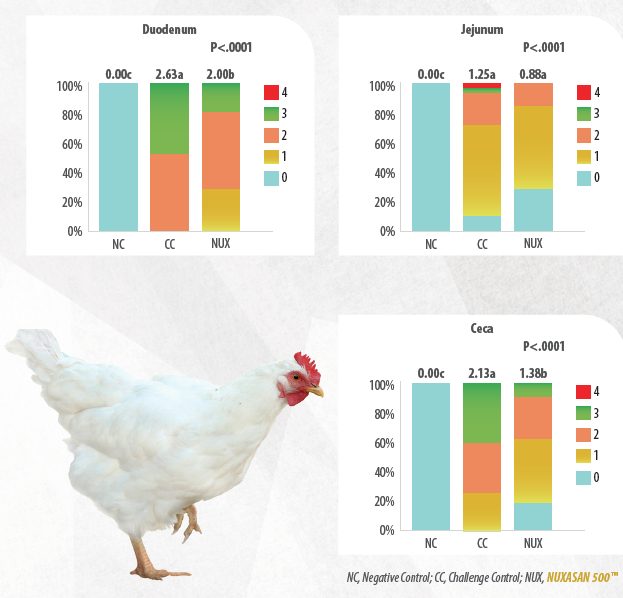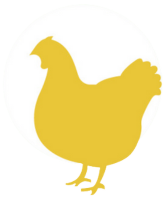Scientific study
Read more content on nutriNews International September 2024
Read more content on nutriNews International September 2024
Effects of NUXASAN 500™ on the performance and intestinal health of broilers challenged with Eimeria spp.
Coccidiosis, a disease caused by species of the genus Eimeria, is one of the most economically devastating diseases in the poultry industry. The result of infection caused by this parasite can lead to variable clinical signs, from subclinical diarrhea to more serious cases with increased mortality. The low weight gain and poor feed conversion generated by this condition cause significant economic losses in a combination of direct and indirect costs:
1. Direct costs:
2. Indirect costs:
3. Long-term economic impact:

Traditionally, the prevention and control of coccidiosis has been based on chemoprophylaxis, anticoccidial products (coccidiostats and coccidicides) and the vaccination of birds with selected Eimeria oocysts. However, there are several concerns associated with their use:
1. Drug resistance:
2. Residues in Food Products:
3. Environmental Impact:
4. Animal Welfare:
5. Regulatory compliance and monitoring:
To address these concerns, a multi-faceted approach involving regulatory oversight, industry practices and scientific research is needed to ensure safe and cost-effective strategies to control avian coccidiosis while protecting public health, animal welfare and the environment.

In response to growing concerns about the use of drugs, synthetic additives and resistance in poultry production, there is increasing interest in natural phytogenic supplements, which aligns with the growing demand for organic animal products in the global market.
Scientific study


In this context, a study was carried out at the University of Georgia, USA, to investigate the effects of NUXASAN 500™ (Nuproxa Switzerland, Ltd.), a product of natural origin, as an alternative strategy to synthetic anticoccidials. The work evaluated its effect on performance, intestinal integrity, oocyst count, expression of pro-inflammatory cytokines and on the antioxidant system at the level of the intestinal mucosa in broilers experimentally challenged with Eimeria spp.
A total of 288 one-day-old male Cobb 500 broilers were randomly assigned to 3 treatments with 8 replicates per treatment and 12 birds per cage for 28 days. The treatments were: Negative Control, NC (basal diet, not challenged), Challenge Control, CC (basal diet challenged with Eimeria spp.) and CC + 500 ppm NUXASAN 500™ (NUX). Birds in the CC and NUX groups were orally inoculated with 62,500 oocysts of E. acervulina, 12,500 oocysts of E. maxima and 12,500 oocysts of E. tenella on day 14, and the NC group was orally inoculated with the same amount of PBS.
Table 1. Performance results at 28 days.
NC, Negative Control; CC, Challenge Control; SEM, standard error of the mean.
Table 1 shows the performance results at 28 days, where the birds in the NUXASAN 500™ group were significantly heavier, with lower FCR and mortality.
As shown in Figure 1, the use of NuxaSan 500™ achieved a significant reduction in the excretion of oocysts (P<0.05) of E. tenella at 6-7-8-9 days post-inoculation (DPI), E. maxima at 7 and 9 DPI and E. acervulina at 6 DPI (P=0.055).
Figure 1. Oocyst sheding counts in feces of broilers challenged with Eimeria spp. CC, Challenge Control; NUX, NUXASAN 500™. *shows significant differences at p<0.05.
The CC group also had numerically the highest incidence of severe lesions and an average score of high lesions in the duodenum, jejunum and caecum. NuxaSan 500™ mitigated the incidence of severe and very severe lesions in the duodenum and caecum caused by Eimeria spp.
Figure 2. Effect of treatments on intestinal lesion score at 6 DPI in broilers challenged with Eimeria spp. (from 0 = no macroscopic lesion to 4 = very severe lesion, numerous blood clots, characteristic colour and odour). “a-c” different letters between columns shows statistical differences p<0.05.

In gene expression analyses, challenge with Eimeria spp. increased (P<0.05) the gene expression of claudin 1 (CLDN-1) and pro-inflammatory cytokines – interleukins IL-1β, IL-6, TNF-α and IFN-γ in the jejunum compared to the NC group; in contrast, in NUXASAN 500™ group, the gene expression of CLDN-1 and IL-1β, TNF-α in jejunum was reduced (P<0.0001) and the expression of the enzyme glutathione peroxidase (GPx) in the jejunum was numerically increased compared to the CC group.  |
Conclusions


The economic impact of coccidiosis in poultry is significant, affecting both large-scale commercial operations and small-scale producers. Effective management strategies, including good biosecurity practices and the development of alternative treatments, are essential to mitigate these costs and ensure the sustainability and profitability of the poultry industry.
Supplementation with 500 ppm NUXASAN 500™ effectively mitigated the negative effects caused by the challenge with Eimeria spp., proving to be an efficient nutritional strategy for improving the performance and intestinal health of broilers challenged with coccidiosis, as well as improving the profitability of the system as a whole.
Cinta Sol1, Gerardo Villalobos1, Felipe Horta1, Jihwan Lee2 and Woo Kyun Kim2
1Nuproxa Switzerland Ltd.
2Department of Poultry Science, University of Georgia, USA